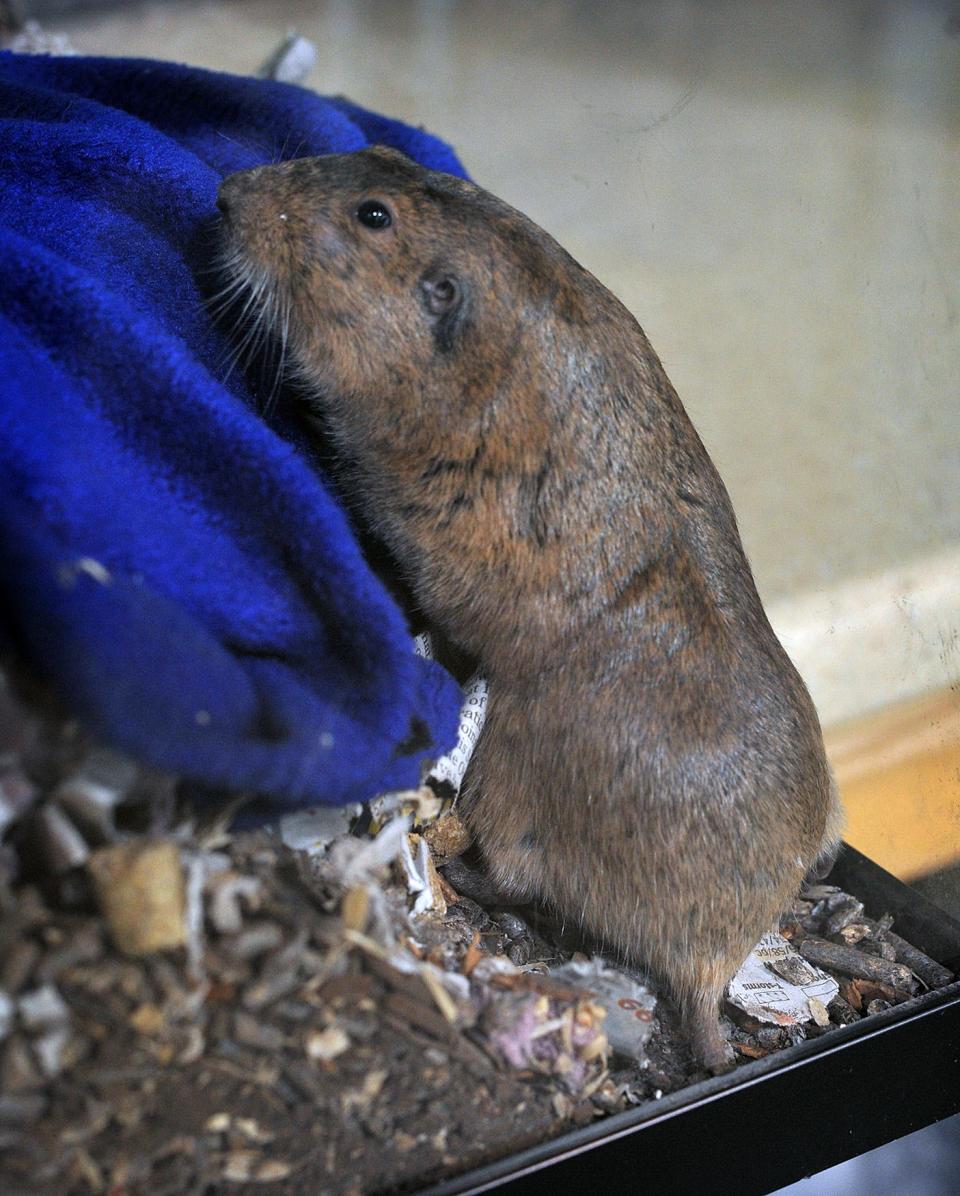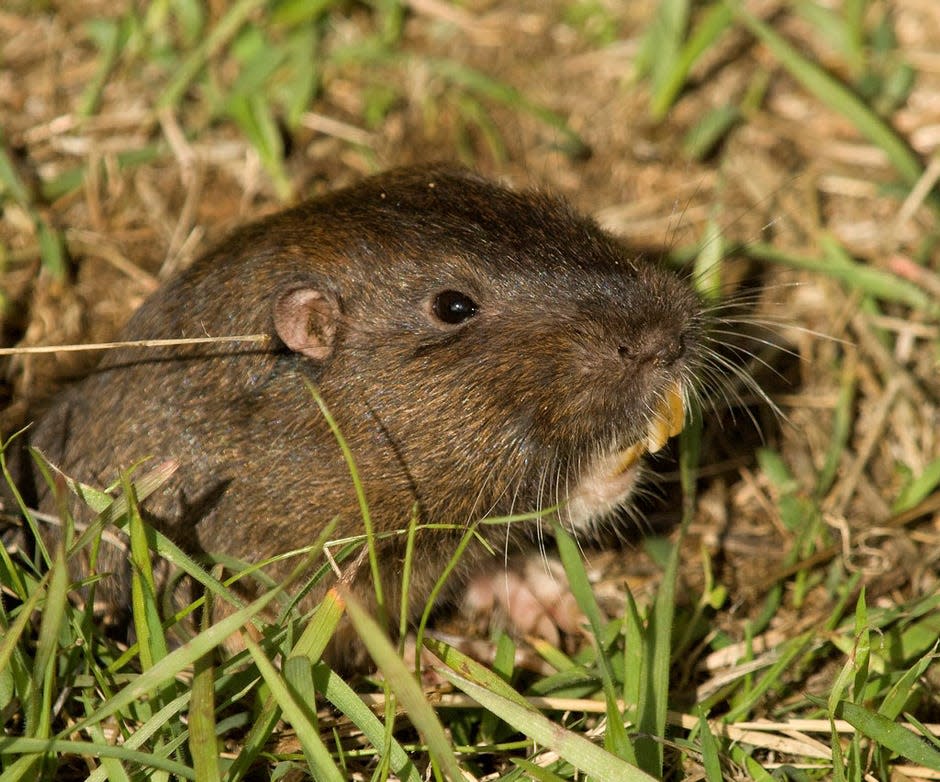Gophers make the groundskeepers grumble
The Plains Pocket Gopher’s range extends throughout much of the Great Plains region of North America and this gopher is found in suitable habitats throughout North Texas and Southwestern Oklahoma. The scientific name of the Plains Pocket Gopher, (Geomys bursarius) is very descriptive when translated and refers to its lifestyle and physical characteristics. Geomys, translated from Latin, means “earth mouse” and bursarius means “purse bearer”: referring to the gopher’s fur-lined cheek pouches or “pockets.”

Pocket Gophers have a distinctive appearance. They have large, broad heads, round, flat, hairless ear pinnae/lobes, and small, black eyes. Their bodies are six to nine inches long and their tails are sparsely haired, terminally-pointed, flesh-colored and approximately two to three inches long. Forelimbs are heavily muscled with prominent claws on each digit of the manus/hands. Hindlimbs are short and the feet possess well-developed claws. Pocket gophers are best described as “cigar-shaped,” or fusiform, with the head and shoulders slightly wider than the hips. Pocket gophers have yellowish, evergrowing upper and lower incisors which are clearly visible when the mouth is closed. The gophers have a slight “overbite”; wherein the larger, double-grooved upper incisors are oriented slightly forward of the lower incisors. This arrangement helps sharpen the cutting edges of the incisors and allows the gopher to use its upper incisors as chisels to loosen soil during excavating and tunneling. The fur is soft, uniform, and usually darker colored on the dorsal and lateral sides; whereas, the belly is a paler, grayish white color. Pelage/fur colors range from a sandy, tan color to a darker brown. Pelage color is correlated with the soil color where the gophers reside.
The Plains Pocket Gopher occupies habitats with sandy and/or loamy soils thoughout our region. A sure sign of pocket gophers in an area is the numerous fan-shaped mounds of soil that result from their extensive tunneling activities. These “gopher mounds” are found on cultivated lands, pasture land, elevated roadsides and ditches, along and above the flood zones of streams and rivers, and (often to our great annoyance) suitable soils in yards, gardens, parks, golf courses, and cemeteries.
Plains Pocket Gophers are most limited by the depth and composition of soils, drainage and flooding tendencies of an area, and the presence of waterways: such as wide, permanent streams, rivers, ponds, and lakes (gophers don’t swim very well). Soil characteristics and topography rather than vegetation seem to play the greatest roles in pocket gopher distributions. Gophers spend more than 90% of their time underground engaged in sleeping, eating, and excavating tunnels and chambers within extensive burrow systems. Digging is accomplished using their robust forelegs and the long claws of their hands, and, occasionally, the upper incisors. Folds of skin extend into the mouth and surround the incisor teeth to prevent the gopher from swallowing soil while digging. Loose and excess soils are pushed out of a burrow’s entrance (sometimes there are several surface entrances in a single gopher’s burrow system) with the head and forefeet: thus forming the conspicuous gopher mounds.
Gophers are active throughout the year and conduct most of their foraging and digging activities during the afternoon and evening hours. This bimodal activity pattern helps reduce temperature and moisture fluctuations within the burrow system. Foraging burrows vary in length from approximately 30 to greater than 100 meters and depths of 5 – 24 centimeters. The burrow system also has a deeper, grass-lined nest chamber and separate chambers for a latrine and food storage.

The Plains Pocket Gopher is almost exclusively herbivorous and its diet includes various types of roots, stems, tubors, bulbs, leaves, and green vegetation. Known diet items include alfalfa, clovers, dandelions, Johnson grass and other grasses, and sunflower tubers. Suitable foods are located by smell, touch, and taste as the animals tunnel and travel through their burrows. Foraging tunnels are concentrated in areas with abundant food resources. The gophers use their cheek pouches to transport extra food items to food storage chambers and obtain all the moisture they require from their herbaceous diet. Gophers have few natural predators but are occasionally captured above ground by owls and hawks and below ground by specialist predators such as badgers, snakes, and weasels.
Pocket gophers are solitary, anti-social (except during mating season), and become aggressive and pugnacious whenever encountering another gopher. However, the Plains Pocket Gopher seems tolerant of a number of other animals cohabitating within their burrow systems. Some of these extra tenants include boxturtles, skinks, toads, earth snakes, and many different species of beetles, flies, camel crickets, and other insects. Reproduction occurs from January through October or November in our region and a single litter of two to five young is commonly produced. The lifespans of pocket gophers vary; but individuals may live from four to seven years in the wild.
The Plains Pocket Gopher’s tunneling and foraging activities sometimes damage crops, trees, orchards, gardens, lawns, parks and other areas if it reaches high population densities. Several different types of traps and chemicals are available for gopher control and/or eradication. Some alternative, non-lethal solutions to pesky Plains Pocket Gophers include placing wire mesh barriers two to three feet below ground along borders and garden areas and/or planting lavender, sage, oleander, salvias, and garlic. Castor oil and fish oil repellents are also effective gopher deterrents.
Look for gopher mounds as you travel through our region and you may occasionally see a pocket gopher cleaning out one of its burrow entrances! Also, you might lure a Plains Pocket Gopher to the surface by digging down and opening a surface entrance to its burrow system. The gopher usually comes to investigate and you’ll get a glimpse of the earth mouse as it works to close the entrance (waiting for the resident gopher will require patience)! Although gophers are sometimes pests to humans, other animals use their burrows as refuges: so they can’t be all bad, can they?
This article originally appeared on Wichita Falls Times Record News: Gophers make the groundskeepers grumble

